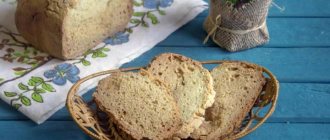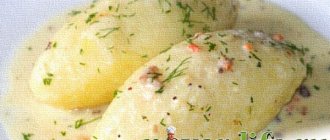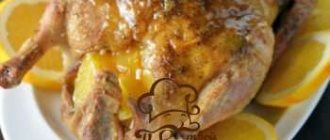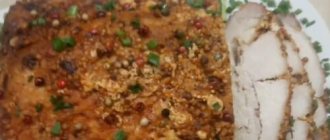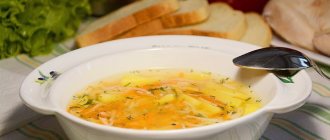There are enough creepy dishes in the world that not everyone dares to try. Somewhere they eat snakes and insects, in other places the smell of a culinary masterpiece will make you dizzy, and there are dishes, the very sight of which raises serious doubts. Scottish haggis It doesn't look very appetizing, to put it mildly. But if you refuse it on January 25, you may be accused of disrespect for great poetry.
Scottish haggis (Nanny with liver)
INGREDIENTS
- veal – 400 g
- garlic – 2 cloves
- vegetable oil – 2 tbsp. l.
- pork or beef liver – 400 g
- fatty pork belly – 100 g
- onions – 2 pcs.
- marjoram – 0.5 tsp.
- lamb rennet or pork stomach – 1 pc.
- ready-made buckwheat porridge – 200 g
STEP-BY-STEP COOKING RECIPE
Scoop out the stomach well, rinse, cover with salt and leave overnight in the cold, rinse again. Cut the liver, veal and brisket into small pieces, season with salt and pepper to taste. Chop the onion and garlic, fry in vegetable oil for 2–3 minutes, mix with marjoram and buckwheat porridge, remove from heat, add meat and liver, stir. Place the filling in the prepared stomach so that the smooth side is on the outside, and sew it up almost completely with harsh thread. Little by little, allowing it to be absorbed, pour 1 glass of water into the stomach. Sew it up completely and place it in a baking dish of suitable size. Cook in an oven preheated to 170°C for 3 hours, sprinkling with water from time to time. Remove the haggis from the oven and cut into rounds.
How an animal became a dish
Those in the know will probably remember Robert Burns' poem "Ode to Haggis." The poet's birthday is a national holiday in the country, and one of the traditional Scottish dishes, haggis, is an obligatory part of his menu. This national food is especially delicious on a frosty January evening with excellent local whiskey.
There are two versions about the origin of the name of the dish. The first, scientific one, says that it comes from the word haggen - to chop. The second, more romantic and sad, and essentially humorous, tells about wild animals (Haggis scoticus) .
According to legend, these were small creatures with a hedgehog's face and short wings covered with bird feathers mixed with fur. Nature made sure that they could move nimbly along the mountain slopes, giving them right and left legs of different lengths. Unfortunately, this feature prevented the animals from reproducing, and they became extinct long ago, but stylized “stuffed animals” of incredible creatures can still be seen in the design of some Scottish pubs.
Interestingly, during the Burns Night celebration, it is customary to try this national dish while bagpipes play. The Scots jokingly say that the sounds produced from the instrument are the dying squeak of a haggis.
There is another version, composed specifically for tourists. They say the animals can still be seen on the Scottish hills. The spread of the story led to the fact that some American tourists surveyed seriously believed and argued that the haggis is a real animal!
Scottish haggis
If you're looking for something a little more exotic tonight, try making Scotland's national dish. Share
Necessary:
100 g lamb kidneys 100 g lamb tongues 100 g lamb heart 100 g lamb lungs 100 g lamb fat 2 tbsp. pearl barley 2 tbsp. oatmeal 200 ml broth or water 1 onion 2 cloves garlic salt - to taste
For mashed potatoes: 300 g potatoes 15 g butter Nutmeg - to taste Rosemary - to taste Salt - to taste
For pumpkin puree: 300 g pumpkin 30 ml cream salt - to taste
Components
How to cook: 1. Finely chop the lamb offal and onion.
2. Fry the onion in lamb fat until golden brown. Add lamb giblets and fry for 10 minutes.
3. Pour in broth or water. Add finely chopped garlic, salt, reduce heat and simmer until tender. 4. Add pearl barley and oatmeal, cooked until half cooked, to the stewed giblets and mix well.
5. Simmer under the lid for 20 minutes. 6. Prepare mashed potatoes with ground nutmeg, butter and rosemary. 7. Prepare puree from boiled pumpkin with the addition of cream.
8. Serve haggis with potato and pumpkin puree.
"Operation Haggis" One of the strangest stories of the Korean War
But what is not a story is “Operation Haggis”, which was carried out by the Australian Air Force during the Korean War. The story seems strange and looks more like war stories, but, in all likelihood, it is quite true. It all started with the fact that during this conflict, the Argyll and Sutherland Regiment of Scots, who fought against the Red Menace, for some reason urgently needed almost a hundredweight of haggis.
Why they needed it - to raise morale, or to intimidate the enemy - is unclear. However, the Allied Air Force, represented by the 30th squadron of the Royal Australian Air Force, carried out a real operation to urgently transfer and airdrop the haggis to the location of the Scottish unit. Of course, the dish had to remain fresh and not burst when planted (this is where the athletic skills of the throwers would come in handy). The maneuvers were successful and the Argyllians and Sutherlanders received their 82 kilograms of haggis. What they did with them - they threw them at the enemy to demoralize them, or ate them - history is silent, but it’s not bad anyway.
Now things are just looking up for haggis. Fans of Burns's poetic talent still offer him enthusiastic praise. It was legalized after decades of oppression and unfair vilification in the States. Soon a new record appeared for his sports throwing over a distance, and Scottish Jews created a special kosher haggis, which they have already nicknamed “nosher” and recommend it to everyone who is concerned about kashrut. Haggis seems to be taking over the world little by little. We just have to wait until he finally becomes the king of fast food.
Scottish dish haggis
- Pork stomachs 1 pc.
- Pork heart 800gkg
- Pork liver 200gkg
- Light 400gkg
- Onions 200grkgpcs.
- Oatmeal 200g
- Meat broth 5l
- Spices:
- Nutmeg to taste
- Ground black pepper to taste
- Ground red pepper to taste
- Ground coriander to taste
- Sea salt to taste
- For soaking:
- Water 2l
- Salt 20g
- Vinegar 20ml
Cooking method
The principle of making haggis is not as complicated as it might seem at first. By and large, offal can be taken from pork, beef, or lamb. The latter are a priority, so ideally haggis is prepared from them. But since it’s easier to get pork by-products, let’s prepare a dish from them. The principle is the same. 1. Wash the stomach thoroughly under running water. Place on a work surface, remove excess fat, mucus and films. We turn it inside out and do the same from the inside. Wash your stomach again. 2. Pour cold water into a bowl, pour vinegar here and add salt, mix. Place the prepared stomach in the resulting solution and leave for 8 hours (the easiest way is to prepare the stomach in the evening and leave it in the solution overnight). 3. Pour oatmeal into a separate bowl, fill with cold water, and leave to swell for 4 hours. 4. We also cleanse the heart of fat deposits, prepare the liver and lungs accordingly. All offal must be thoroughly cleaned of excess fat, films, veins, and blood clots. Then I wash my heart, liver and lung under running water. 5. Place the offal in a saucepan and add water so that it completely covers them. Place on the fire and cook for two hours over low heat. Don't forget to add salt to taste. 6. Remove the boiled giblets from the broth, cool, then chop as finely as possible and place in a large bowl. Peel the onion, cut it into small cubes, and add it here. Following the onions, add oatmeal to the bowl. We enrich it with spices: ground red and black pepper, nutmeg, coriander, sea salt. Pour in the broth (one glass will be enough, it’s 200 ml). Mix everything thoroughly. 7. Fill the stomach with the prepared mixture to 2/3 of the total volume. There is no need to compact it too much, as the oatmeal will swell during cooking and the stomach itself will shrink a little. We sew up the opening of the stomach, and pierce the walls with a needle in several places so that during the cooking process there is room for air to escape. 8. Well, we place the stomach in a saucepan, fill it with the broth in which the giblets were cooked, put it on low heat, and cook for 3 hours. Serve the haggis hot. Usually it is served on a common dish, making a cross-shaped cut with a knife, and those sitting at the table put the contents on their plate. You can serve mashed potatoes as a side dish, but this is optional. Bon appetit!
Sources
- https://xcook.info/recipe/shotlandskoe-bljudo-haggis.html
- https://www.gastronom.ru/recipe/10166/shotlandskij-haggis-nyanya-s-pechenkoj
- https://domashniy.ru/recepty/shotlandskij_haggis/
- https://1000.menu/cooking/27043-shotlandskoe-bludo-xaggis
[collapse]
The Legend of the "Wild Haggis"
But the Scots would not be Scots if they did not go even further in their passion for haggis and fun. Aware of the interest of strangers in the original Celtic culture, and also clearly considering this interest superficial, local residents created the legend of the “wild haggis”. According to this story, which over time has acquired a whole heap of imaginary details, the real, original dish is made not from sheep’s offal, but from the beast of the same name.
According to the legend created for visiting tourists, the wild haggis is a mountain animal, about the size of an opossum, that has lived here from time immemorial. It has a very strange property: one half of the legs is much shorter than the other, and we are not talking about back-front, but left-right. Thanks to this physiology, wild haggis moves extremely quickly through the mountains of Scotland - such an evolutionary advantage. But it has its own disadvantage: due to the asymmetry, the animal can only move in one direction. Those with longer left paws wind circles around the mountain strictly clockwise; those with longer right ones are counterclockwise. Because of this, the poor creatures are even divided into two species: the haggis with odd legs cannot mate.
No matter how wild and unbridled the imagination of those who came up with this legend may be, there are people who willingly believe in it. According to surveys of American tourists, a third of them were convinced and the “wild haggis” remained in their memory as an absolutely real beast.




